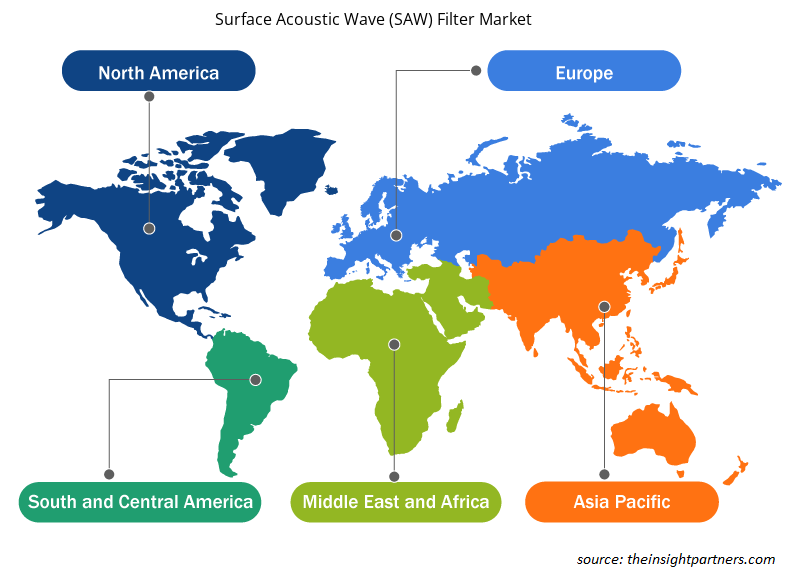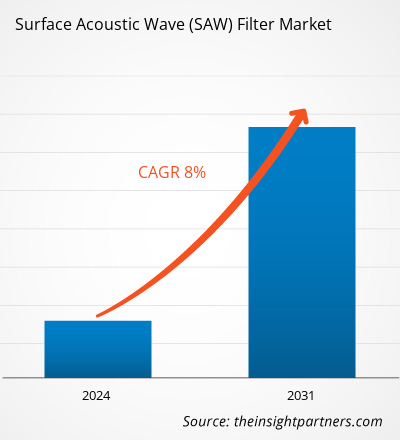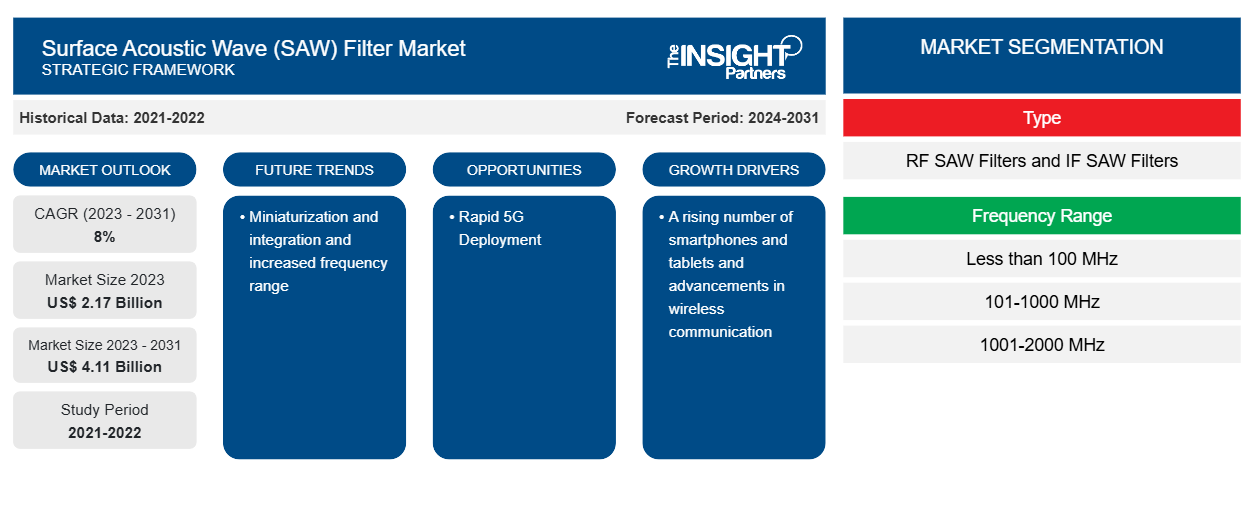Der Markt für Oberflächenwellenfilter (SAW) soll von 2,17 Milliarden US-Dollar im Jahr 2023 auf 4,11 Milliarden US-Dollar im Jahr 2031 anwachsen. Der Markt wird im Zeitraum 2023–2031 voraussichtlich eine durchschnittliche jährliche Wachstumsrate (CAGR) von 8,0 % verzeichnen. Miniaturisierung und Integration sowie ein erhöhter Frequenzbereich dürften weiterhin ein wichtiger Trend auf dem Markt bleiben.CAGR of 8.0% during 2023–2031. Miniaturization and integration and increased frequency range are likely to remain a key trend in the market.
Marktanalyse für Oberflächenwellenfilter (SAW)
Die beliebteste Klasse von SAW-Filtern wird häufig in Fernseh- und Radiosystemen für Privathaushalte verwendet, darunter Basisstationen und Mobiltelefone. Es gibt zahlreiche Varianten, jede mit einzigartigen Vorteilen, darunter geringe Größe, Hochfrequenzfunktion, minimale Einfügungsdämpfung und niedriger Formfaktor. Die extreme Präzision, mit der auf der Oberfläche nahezu unbegrenzte Formen gebildet werden können, macht eine große Bandbreite an Typen denkbar.
Marktübersicht für Oberflächenwellenfilter (SAW-Filter)
Oberflächenwellenfilter sind ein wichtiger Bestandteil digitaler Fernsehgeräte und Mobiltelefone. In jedem Smartphone und anderen IoT-Geräten device sind SAW-Filter nach wie vor eine entscheidende Komponente des Kommunikationsmoduls. Die SAW-Technologie bietet kostengünstige Lösungen für viele verschiedene Einsatzzwecke. SAW-Komponenten sind aufgrund ihrer günstigen Preise eine bessere Option für Kunden, die eine Produktion in großen Stückzahlen benötigen. Die Entwicklungszeit von SAW-Komponenten wird dank ausgefeilter Simulationstools und der neuesten Fortschritte in der Halbleiterprozesstechnologie auf wenige Wochen verkürzt.
Passen Sie diesen Bericht Ihren Anforderungen an
Sie erhalten kostenlos individuelle Anpassungen an jedem Bericht, einschließlich Teilen dieses Berichts oder einer Analyse auf Länderebene, eines Excel-Datenpakets sowie tolle Angebote und Rabatte für Start-ups und Universitäten.
-
Holen Sie sich die wichtigsten Markttrends aus diesem Bericht.Dieses KOSTENLOSE Beispiel umfasst eine Datenanalyse von Markttrends bis hin zu Schätzungen und Prognosen.
Markttreiber und Chancen für Oberflächenwellenfilter (SAW)
Steigende Anzahl an Smartphones und Tablets begünstigt den Markt
SAW-Filter sind nach wie vor ein wichtiger Bestandteil jedes Smartphones und werden seit der ersten Generation von Mobiltelefonen von Herstellern verwendet. Seit der Einführung von LTE wird eine breite Palette von Funkfrequenzbändern oder LTE-Bändern von 600 MHz bis 2700 MHz von Smartphones unterstützt. Um eine globale Netzwerkkompatibilität sicherzustellen, integrieren Smartphone-Hersteller die meisten häufig verwendeten LTE-Bänder. Durch 5G wurde für frühere Bereitstellungen eine Bandbreite unter 6 GHz verfügbar, und SAW-Filter sind in der Lage, die meisten Frequenzen im unteren Band zu erfassen. SAW-Filterlösungen bieten leistungsstarke Duplexer und Multiplexer für HF-Kommunikationsmodule, die moderne Mobilgeräte antreiben. Weltweit ist die Smartphone- Nutzung in Industrieländern nahezu universell. Schätzungen aus dem Jahr 2023 zufolge sind derzeit weltweit mehr als 6,5 Milliarden Smartphones im Einsatz, und diese Zahl wird in den kommenden Jahren voraussichtlich steigen. Dies soll die Nachfrage auf dem Markt für Oberflächenwellenfilter (SAW) ankurbeln.LTE, a wide range of radio frequency bands, or LTE bands, from 600MHz to 2700MHz, have been supported by smartphones. In order to ensure global network compatibility, smartphone manufacturers incorporate the majority of LTE bands that are often used. Sub-6GHz bandwidth was made available by 5G for earlier deployments, and SAW filters are capable of capturing the majority of lower-band frequencies. SAW filter solutions provide high-performance duplexers and multiplexers for RF communication modules that power contemporary mobile devices. Globally,
Schnelle 5G-Bereitstellung
Der Bedarf an SAW-Filtern wird durch die Einführung der 5G-Technologie und die Verbreitung von Geräten des Internets der Dinge (IoT) vorangetrieben. Für den Betrieb dieser Anwendungen in komplizierten Funkumgebungen ist eine präzise Filterung erforderlich. Ziel laufender Forschungen ist es, die Größe von SAW-Filtern weiter zu reduzieren, damit sie ohne Funktionseinbußen in immer kleinere elektronische Geräte passen. Darüber hinaus werden Anstrengungen unternommen, um die Produktionskosten zu senken und die Leistung zu verbessern, indem SAW-Filter mit anderen Teilen auf einem einzigen Chip integriert werden.IoT) devices. Precise filtering is necessary for these applications to operate in complicated radio environments. The goal of ongoing research is to further reduce the size of SAW filters so they can fit into progressively smaller electronic devices without sacrificing functionality. Efforts are also underway to lower production costs and enhance performance by integrating SAW filters with other parts on a single chip.
Segmentierungsanalyse des Marktberichts für Oberflächenwellenfilter (SAW)
Wichtige Segmente, die zur Ableitung der Marktanalyse für Oberflächenwellenfilter (SAW) beigetragen haben, sind Typ, Frequenzbereich und Anwendung.
- Basierend auf dem Typ ist der Markt für Oberflächenwellenfilter (SAW) in RF-SAW-Filter und IF-SAW-Filter unterteilt. Das Segment RF-SAW-Filter hatte im Jahr 2023 den größten Anteil.
- Basierend auf dem Frequenzbereich ist der Markt in weniger als 100 MHz, 101–1000 MHz, 1001–2000 MHz und mehr als 2000 MHz unterteilt.
- Basierend auf der Anwendung wird der Markt in Unterhaltungselektronik, Automobil, Luft- und Raumfahrt und Verteidigung, Telekommunikation und Sonstige unterteilt.
Marktanteilsanalyse für Oberflächenwellenfilter (SAW) nach geografischer Lage
Der geografische Umfang des Marktberichts für Oberflächenwellenfilter (SAW) ist hauptsächlich in fünf Regionen unterteilt: Nordamerika, Asien-Pazifik, Europa, Naher Osten und Afrika sowie Süd- und Mittelamerika.
Der asiatisch-pazifische Raum hält im Jahr 2023 einen bedeutenden Anteil am Markt für Oberflächenwellenfilter (SAW). Der asiatisch-pazifische Raum ist das Produktionszentrum der Halbleiterindustrie. Länder wie Südkorea, Japan und China sind wichtige Zentren der Halbleiterproduktion. Darüber hinaus gibt es in der Region eine beträchtliche Anzahl von Smartphone-Herstellern, die die Nachfrage nach SAW-Filtern in der Region ankurbeln.
Regionale Einblicke in den Markt für Oberflächenwellenfilter (SAW)
Die regionalen Trends und Faktoren, die den Markt für Oberflächenwellenfilter (SAW) im Prognosezeitraum beeinflussen, wurden von den Analysten von Insight Partners ausführlich erläutert. In diesem Abschnitt werden auch die Marktsegmente und die Geografie von Oberflächenwellenfiltern (SAW) in Nordamerika, Europa, im asiatisch-pazifischen Raum, im Nahen Osten und Afrika sowie in Süd- und Mittelamerika erörtert.

- Erhalten Sie regionale Daten zum Markt für Oberflächenwellenfilter (SAW-Filter)
Umfang des Marktberichts zu Oberflächenwellenfiltern (SAW)
| Berichtsattribut | Details |
|---|---|
| Marktgröße im Jahr 2023 | 2,17 Milliarden US-Dollar |
| Marktgröße bis 2031 | 4,11 Milliarden US-Dollar |
| Globale CAGR (2023 - 2031) | 8 % |
| Historische Daten | 2021-2022 |
| Prognosezeitraum | 2024–2031 |
| Abgedeckte Segmente |
Nach Typ
|
| Abgedeckte Regionen und Länder |
Nordamerika
|
| Marktführer und wichtige Unternehmensprofile |
|
Dichte der Marktteilnehmer für Oberflächenwellenfilter (SAW): Auswirkungen auf die Geschäftsdynamik verstehen
Der Markt für Oberflächenwellenfilter (SAW) wächst rasant, angetrieben durch die steigende Nachfrage der Endnutzer aufgrund von Faktoren wie sich entwickelnden Verbraucherpräferenzen, technologischen Fortschritten und einem größeren Bewusstsein für die Vorteile des Produkts. Mit steigender Nachfrage erweitern Unternehmen ihr Angebot, entwickeln Innovationen, um die Bedürfnisse der Verbraucher zu erfüllen, und nutzen neue Trends, was das Marktwachstum weiter ankurbelt.
Die Marktteilnehmerdichte bezieht sich auf die Verteilung von Firmen oder Unternehmen, die in einem bestimmten Markt oder einer bestimmten Branche tätig sind. Sie gibt an, wie viele Wettbewerber (Marktteilnehmer) in einem bestimmten Marktraum im Verhältnis zu seiner Größe oder seinem gesamten Marktwert präsent sind.
Die wichtigsten auf dem Markt für Oberflächenwellenfilter (SAW) tätigen Unternehmen sind:
- Murata Manufacturing Co., Ltd.
- API Technologies (UK) Ltd.
- Abracon
- Qualcomm Technologies, Inc.
- Qorvo, Inc.
- Skywork Solutions, Inc.
Haftungsausschluss : Die oben aufgeführten Unternehmen sind nicht in einer bestimmten Reihenfolge aufgeführt.

- Überblick über die wichtigsten Akteure auf dem Markt für Oberflächenwellenfilter (SAW)
Neuigkeiten und aktuelle Entwicklungen zum Markt für Oberflächenwellenfilter (SAW-Filter)
Der Markt für Oberflächenwellenfilter (SAW) wird durch die Erfassung qualitativer und quantitativer Daten nach Primär- und Sekundärforschung bewertet, die wichtige Unternehmensveröffentlichungen, Verbandsdaten und Datenbanken umfasst. Nachfolgend sind einige der Entwicklungen auf dem Markt für Oberflächenwellenfilter (SAW) aufgeführt:
- Murata Manufacturing Co., Ltd. (Hauptsitz: Nagaokakyo-shi, Kyoto; Vorstandsvorsitzender und Präsident: Tsuneo Murata) hat die weltweit kleinsten*1 SAW*2-Duplexer*3 – die SAYAV-Serie, SAYARV-Serie und SAYAP-Serie – sowie SAW-Filter – die SAFFW-Serie (nachfolgend „die Produkte“) – entwickelt und mit der Serienproduktion begonnen. (Quelle: Murata Manufacturing Co., Ltd., Pressemitteilung, Juli 2019)
- Qualcomm Technologies, Inc. hat eine neue Generation mikroakustischer Filtertechnologie vorgestellt, die unser RF-Frontend-Portfolio (RFFE) erweitert und neue 5G-Dienste und -Anwendungen ermöglicht. (Quelle: Qualcomm Technologies, Inc., Pressemitteilung, Oktober 2021)
Marktbericht zu Oberflächenwellenfiltern (SAW-Filtern): Umfang und Ergebnisse
Der Bericht „Marktgröße und Prognose für Oberflächenwellenfilter (SAW) (2021–2031)“ bietet eine detaillierte Analyse des Marktes, die die folgenden Bereiche abdeckt:
- Marktgröße und Prognose für Oberflächenwellenfilter (SAW-Filter) auf globaler, regionaler und Länderebene für alle wichtigen Marktsegmente, die im Rahmen des Berichts abgedeckt sind
- Markttrends für Oberflächenwellenfilter (SAW) sowie Marktdynamiken wie Treiber, Einschränkungen und wichtige Chancen
- Detaillierte PEST/Porters Five Forces- und SWOT-Analyse
- Marktanalyse für Oberflächenwellenfilter (SAW-Filter), die wichtige Markttrends, globale und regionale Rahmenbedingungen, wichtige Akteure, Vorschriften und aktuelle Marktentwicklungen umfasst
- Branchenlandschaft und Wettbewerbsanalyse, einschließlich Marktkonzentration, Heatmap-Analyse, prominenten Akteuren und aktuellen Entwicklungen auf dem Markt für Oberflächenwellenfilter (SAW-Filter).
- Detaillierte Firmenprofile
- Historische Analyse (2 Jahre), Basisjahr, Prognose (7 Jahre) mit CAGR
- PEST- und SWOT-Analyse
- Marktgröße Wert/Volumen – Global, Regional, Land
- Branchen- und Wettbewerbslandschaft
- Excel-Datensatz
Aktuelle Berichte
Erfahrungsberichte
Grund zum Kauf
- Fundierte Entscheidungsfindung
- Marktdynamik verstehen
- Wettbewerbsanalyse
- Kundeneinblicke
- Marktprognosen
- Risikominimierung
- Strategische Planung
- Investitionsbegründung
- Identifizierung neuer Märkte
- Verbesserung von Marketingstrategien
- Steigerung der Betriebseffizienz
- Anpassung an regulatorische Trends























 Kostenlose Probe anfordern für - Markt für Oberflächenwellenfilter (SAW)
Kostenlose Probe anfordern für - Markt für Oberflächenwellenfilter (SAW)